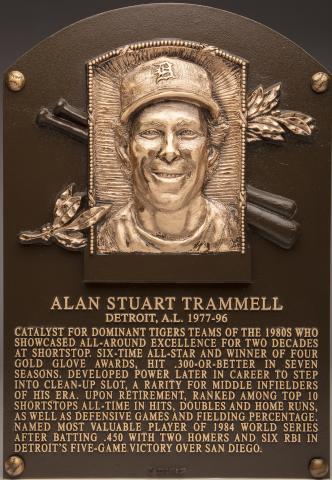
Class of: 2018 (Veterans Committee)
Team: Tigers
Key Stats: 63.7 WAR, 111 wRC+, 184.4 DEF Runs
If it’s difficult to live in the shadows of giants, it’s even tougher to live in those giants’ presence. The 1980’s saw the rise of two of the greatest shortstops of all-time who would both redefine the position in unique ways. Ozzie Smith’s acrobatic fielding and three NL Pennants changed how people defined great defensive shortstops, while Cal Ripken demonstrated that tall guys that hit for power can play the position well, too. Both truly legendary players towered over the position and made it difficult for other players to stand out some. Barry Larkin in the NL never got the love that Ozzie got, and over in the AL, Alan Trammell never got the respect he deserved thanks to Ripken and Robin Yount who both took the spotlight away from one of the finest shortstops in history.
Trammell was one of those players that didn’t typically excel in any one area, but wasn’t deficient in any area either. There have been players that you could say similarly about (i.e., George Kell), but what puts Trammell apart from them is that he was usually great in all aspects rather than just being solid. He began his career (following 19 games as a callup in 1977) with an excellent rookie performance with 2.7 WAR and finishing 4th in Rookie of the Year balloting. A down year in 1979 was then followed by more than a decade of high-level play. Beginning in the 1980 season until the 1993 campaign, Trammell failed to top 3 WAR twice (two injury shortened seasons in the early 1990’s). He carried a wRC+ above 100 nine times during that stretch, and only dipped as low as 86 once (with three seasons in the 90’s). He combined that fine hitting with a very valuable glove that saw him put up nine seasons of double-digit fielding runs in that stretch. And he wasn’t just a typical light-hitting shortstop, Trammel had eight campaigns in that stretch where he put up more than 10 homers playing most of his games in a rather spacious Tigers’ Stadium. Combine all of that with double digit steals nearly every season and it adds up to one of the most valuable players of the 1980’s and early 1990’s. Trammell helped guide the Tigers to their first World Series title in 1984 with 6.9 WAR and a 139 wRC+ in the regular season and carrying a 1.300 OPS in the World Series en route to a well-earned World Series MVP award, and probably deserving of the regular season MVP as well (real quick, this is why I don’t add in MVP’s or other awards to these rankings because I don’t think the BBWAA always made the right call.). Trammell was even better in the 1987 campaign when he put up his first 100 RBI and 100 runs scored totals with over 7 WAR and somehow finished second to George Bell in MVP voting (1987 was not a good year for shortstops and the MVP as Ozzie lost out in the NL, too). Even at his best, the BBWAA constantly overlooked Trammell and it’s a shame because he deserved more hardware than he received.
Following a great comeback season in 1993, Trammell began a quick and very rapid decline period. He failed to have a wRC+ above 90 in any of the next three seasons, put up below replacement level production in two of those seasons and couldn’t even play very often in the field due to age and injuries catching up to him. Trammell’s 1996 campaign saw him put up a wRC+ of 33 and a WAR of -1.3 and he decided to retire at the end of the year rather than chase a few milestones, which was a good call.
With a plethora of great shortstops during his career, it’d be difficult to call Trammell the best at his position because that would be Cal Ripken’s title. In the non-Ripken division, Trammell would be competing with Smith and Yount for the next-best shortstop and, again, it’s hard to say Trammell would be outright the better of that group. Smith was miles ahead of Trammell on the bases and in the field but Yount and Larkin had very similar careers to Trammell in terms of value (all had 63-67 WAR), but Yount had more durability (and a switch to center field shot his defensive numbers down considerably) and Larkin was slightly better offensively while not losing much defensively (all three are fantastic, however). Yount’s counting stats got him inducted on his first ballot (rightfully so, mind you), while Larkin had to wait a few years to gain induction. Trammell, however, waited the full 15 years on the ballot, never got the call, and then had to wait another year to be on the new Veterans Committee ballot before gaining induction (I think someone else may have gained induction with him, but that can’t be right). Unfortunately, what made Trammell so great was one of the two things that held him back. Trammell didn’t dazzle crowds and writers the way that Ripken, Yount and Smith did, and got overlooked because of it. What else held him back was the fact that Lou Whitaker, who debuted with Trammell and played his entire career as Trammell’s double play partner, was one-and-done off the ballot before Trammell got put on it. The two were so synonymous with each other for so long, many voters may have felt that if Whitaker (absolutely wrongly) wasn’t inducted, then Trammell shouldn’t be either. The fact that Trammell was a shortstop probably helped him remain on the ballot (Whitaker was a second baseman), but certainly didn’t give him the push to get inducted. Alan Trammell was an excellent all-around player, someone that every kid in the 1980’s should have tried to emulate and can now rightfully be called a Hall of Famer.